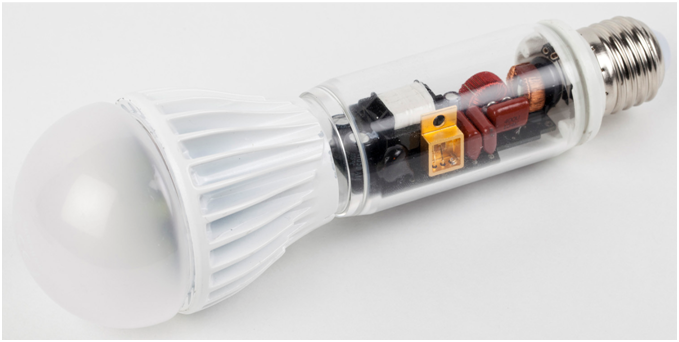Formative Performance of LED Systems
An LED driver is an electrical device that regulates the power to an LED as its electrical properties change with temperature. A key characteristic of any constant current LED driver is its efficiency. Efficiency gives us the amount of input power that can actually be used by the driver, to power the LED. With the fast development of LED technology the need for energy – efficient lighting solution is increasing significantly across the globe. This results in several innovations in LEDs & LED drivers’ field.
 The long life spans and energy savings factors have became a common factor associated with LEDs, along with specialized devices called LED drivers to operate. LED drivers provide LEDs with the electricity they require to function and perform at their best. LEDs require drivers for two purposes:
The long life spans and energy savings factors have became a common factor associated with LEDs, along with specialized devices called LED drivers to operate. LED drivers provide LEDs with the electricity they require to function and perform at their best. LEDs require drivers for two purposes:
- An LED driver rectifies higher voltage, alternating current to low voltage, direct current.
- LED drivers also protect LEDs from voltage or current fluctuations.
Combined with right drivers LEDs & LED based systems not only delivers desired performance but Smart lighting set-ups can be made. LED drivers are available from major semiconductors companies across the world. In the international market, Texas Instruments (TI) LED driver IC has the highest visibility. European and U.S. companies including NXP, Marvell and others have also launched LED driver IC. Asian IC design companies’ optimistic outlook of future developments has led to their active entry into the LED market in 2013. IC design companies including Macroblock, Richtek Technology Corp., On-Bright Electronics Co., Silergy Corp., and Champion Microelectronic Corp. all have plans of entering this market.
Out of the box applications of LEDs achieved the drivers:
The range of the LEDs available in market is much diversified, but to use LED as a raw material for a given application, for ex. mobile flash light, a specified LED is required with dedicated electronics associated. The fact simply illustrated the importance of drivers in a given LED based system and proves, “a suitable driver leads a simple LED to an innovation application.” Some of the breakthrough in the LED based applications is as follows:
- LED Signage: ICs used are, Multi-channel constant-current LED String control products.
- Backlight applications: DC/DC LED drivers with innovative dimming control for backlighting LCD panels.
- Camera Flash Lights: Flash drive solutions
- Indicator/RGBW Lights: Power regulating drivers
- Automotive Lighting: DC/DC and Linear LED drivers.
Streamlined wireless connected lighting system from Philips
Philips Advance Xitanium SR LED Driver provides foundation for connected lighting systems. Philips Advance Xitanium SR LED Drivers standardize the digital connection between the driver and sensor to eliminate the need for multiple separate components and alleviate incompatibility issues and time consuming configurations.
Choosing an LED Driver
In today’s fast-paced and rapidly-changing LED arena, the complex and subtle choices involved in choosing an LED or LED array can be difficult enough. Add to this the confusion of selecting an LED driver in a SSL industry marked by obscure terminology where even the experts’ still debate definitions and standards, and the task can be overwhelming. Lets us explore some of the factors deciding LED drivers.
Constant voltage or current:
Constant-voltage drivers power LEDs that require a fixed output voltage with a maximum output current. In these LEDs, the current is already regulated, either by simple resistors or an internal constant-current driver, within the LED module. These LEDs require one stable voltage, usually 12V DC or 24V DC. In the example below to the right, the output voltage is 24V DC, and the output current is a maximum of 1.04A.
AC LED drivers are actually no-minimum load transformers, meaning they could technically operate low-voltage halogen or incandescent bulbs as well. LEDs, however, cannot operate with conventional transformers because conventional transformers were not made to detect the low wattage of LEDs. AC LED drivers are typically used with bulbs that already contain an internal driver that converts the current from AC to DC, so an AC LED driver’s job is to register the low wattage of LEDs and step down the voltage to meet the bulb’s voltage requirements, usually 12 or 24 volts. AC LED drivers are typically used to power 12-24V AC input LED MR16 bulbs, but they can be used for any 12- 24V AC input LED bulb. The LED bulb datasheet must be carefully examined; if the LED bulb requires DC voltage input, it cannot be used with an AC LED driver.
Other Factors to Consider
- Max Wattage
According to the NEC (National Electrical Code), LED drivers should be paired with LEDs that use 20% less than their maximum rated wattage (with the exception of AC LED drivers). Drivers should not be paired with an LED that is at or exceeds the driver’s maximum wattage to avoid overstressing the driver components. For example, if you have a driver that can operate a maximum of 96 watts, it should only operate LEDs that use 77 watts at most (96 x 0.8 = 76.8).
- Dimming
Both constant-current and constant-voltage LEDs and drivers can be made with a dimming capability, though both LEDs and drivers must specify that they are dimmable on the product datasheet for that assertion to be made. If the specs don’t mention dimming at all, it is safe to assume that the product is not dimmable. Dimmable external drivers often require an external dimmer, or other dimming control devices specified on the product datasheet (namely TRIAC, Trailing Edge, or 1-10v dimmers) to work. Since technologies are improving rapidly, it’s best to test specific LED/dimmable driver combinations for acceptable dimming performance before making large purchases if brand-specific dimmer compatibility
- Power Factor
Power factor describes how efficiently an LED driver uses electricity. It is calculated by dividing the power being used by the driver (wattage) divided by the product of the input voltage times the current going in (volts x amps). The range for power factor is a decimal between 0 and 1. The closer to 1 the power factor is, the more efficient the driver is. A good power factor is 0.9 or above.
- UL Class 1 & UL Class 2
UL Class 2 drivers comply with standard UL1310, meaning output is considered safe to contact and no major safety protection is required at the LED / luminaries level. There is no risk of fire or electric shock. These drivers operate using less than 60 volts in dry applications, 30 volts in wet applications, less than 5 amps, and less than 100 watts. However, these limitations pose restrictions on the number of LEDs a Class 2 driver can operate.
- Ingress Protection (IP) Rating
IP ratings tell users the environmental protection that a driver’s outer casing provides. The first number specifies protection against solid objects, and the second number specifies protection against water elements. For example, according to the chart below, a driver with an IP67 rating is protected against dust and temporary immersion in water.
Some of the other innovations in LED drivers are:
- Power Integrations Launches New Reference Design for High-Power LED-Lighting Applications
- Intertek Launch New “Class P” Service for LED lighting drivers for LED Lighting Manufacturers
- Diodes Incorporated, introduces the AL5809, constant-current LED driver in a robust two-terminal PowerDI®-123 package, and provides an improved accuracy
- Fairchild, announced the FL7733A Single Stage Primary-Side-Regulated (PSR) Fly-back LED Driver for delivering constant brightness and instant flicker-free turn-on of LED lighting.
- Spansion Brightens LED Lighting Market with Intelligent, Single-Chip LED Driver IC
- Exar Releases Enhanced AC Step Driver for LED Lighting Market
LED Drivers makes LED Lighting – Smart Lighting
Energy saving is one of the major concerns for state and national governments globally. Loss of energy through lighting has become national concern for governments. Smart lighting is a new innovation in lighting technology that is developed for energy efficiency. This technology may include efficiency fixtures and automated controls lighting system that make adjustments according to conditions and requirements of the internal or external environment such as occupancy or availability of daylight. Lighting accounts for 20% to 50% of the global consumption of energy. It is essential to use limited electric energy to reduce energy consumption. Market players have been introducing innovative lighting systems that help conserve energy. Smart lighting is a technology that uses intelligent light control system. Factors such as object movement, occupancy, color, temperature and availability of natural light helps smart lighting technology to perform efficiently. This technology uses lighting control systems that deliver the required amount of light optimally. Smart lighting also entails technology that automatically performs various functions at a set time and under a given condition. Smart lighting technology provides highly flexible lighting at low energy consumption and cost.
Europe accounts for the largest market share for smart lighting technology, followed by North America and Asia Pacific. The U.S. is the largest consumer of smart lighting technology, led by increasing consumer awareness about the importance of energy saving. Europe is likely to maintain its dominance in smart lighting technology, while North America is anticipated to experience marginal growth during the forecast period. However, Asia Pacific is expected to witness the highest growth during the forecast period, due to rapid growth in infrastructure development in developing countries such as India and China.
Light manufacturing companies are compelled to introduce innovative lighting technology, especially in developing regions, due to rising demand and higher spending capacity for energy saving equipment by major end-users. Major companies operating in the global smart lighting technology market are Zumtobel AG, Lutron Electronics Company, Inc., Digital Lumens, Inc., Encelium Technologies, Inc., Legrand S.A., Acuity Brands, Inc., Honeywell International, Royal Philips Electronics N.V. and Osram Light AG.


